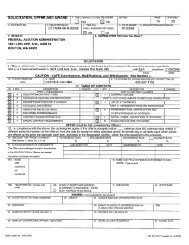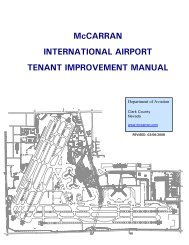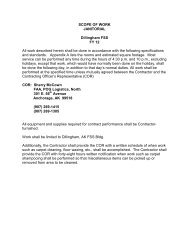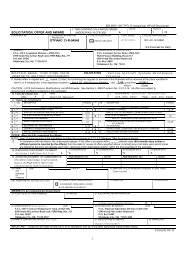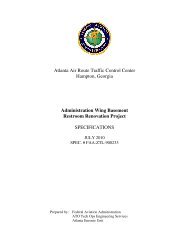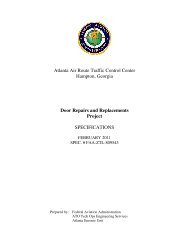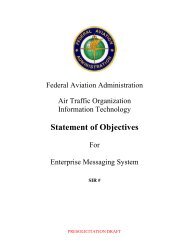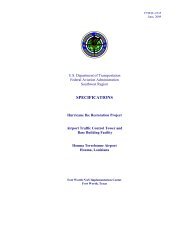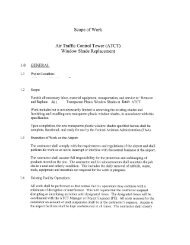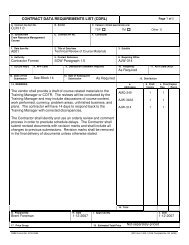scope of work - FAACO - Federal Aviation Administration Contract ...
scope of work - FAACO - Federal Aviation Administration Contract ...
scope of work - FAACO - Federal Aviation Administration Contract ...
You also want an ePaper? Increase the reach of your titles
YUMPU automatically turns print PDFs into web optimized ePapers that Google loves.
A/E Scope <strong>of</strong> Work<br />
Las Vegas ATCT/TRACON<br />
Provide a complete system <strong>of</strong> riser cabling between the Base Building/TRACON and<br />
the ATCT Sub-junction Level using both Single Mode Fiber Optics and surgeprotected<br />
Category 6 copper cabling. Terminate and test the fiber optic cables in a<br />
fiber patch panel. Provide surge suppression on all copper facilities that extend to<br />
upper levels <strong>of</strong> the tower. Deliverables include fiber optic cable test results, floor<br />
plans, riser diagrams, layout drawings, installations detail drawings, bill <strong>of</strong> materials,<br />
and installation and testing specifications and procedures.<br />
3. Develop a Subsurface Utility Plan for a conduit duct bank supporting a Fiber Optics<br />
Transmission System (FOTS) Net<strong>work</strong> connecting all applicable airfield facilities to<br />
the ATCT/TRACON facility. Use 4" steel ducts encased in concrete. Coordinate<br />
with the FAA Project Engineer to determine the number <strong>of</strong> existing and future<br />
conduit runs required. Comply with FAA Order 6000.36A, Communications<br />
Diversity. Utilize existing FAA ducts to the maximum extent possible.<br />
4. LAN and Net<strong>work</strong> Equipment - It is recognized that much <strong>of</strong> the equipment within the<br />
ATCT facility will utilize LAN and other services which, by virtue <strong>of</strong> their speed, must<br />
be multiplexed over a site-wide net<strong>work</strong>. Fiber-optic services which, by virtue <strong>of</strong><br />
their speed, must be multiplexed over a site-wide system for reasons <strong>of</strong> reliability,<br />
route diversity and net<strong>work</strong> management. Space, power, and air-conditioning will be<br />
provided to accommodate this equipment as part <strong>of</strong> this <strong>scope</strong> <strong>of</strong> <strong>work</strong>. The sitewide<br />
net<strong>work</strong>(s) designed to achieve desired levels <strong>of</strong> availability within the site.<br />
Infrastructure outside the boundaries <strong>of</strong> the tower and base building is not included<br />
in the <strong>scope</strong> <strong>of</strong> <strong>work</strong>.<br />
5. Public Address System - A complete public address system shall be provided for the<br />
Base Building/TRACON facility and appropriate areas <strong>of</strong> the tower facility.<br />
Loudspeaker placement and design shall provide uniform coverage at average<br />
sound pressure levels that are suitable for local ambient noise and acoustic<br />
conditions. Microphone, PBX dial access, program material and other inputs will be<br />
provided as dictated by user requirements.<br />
6. Radio Antenna Supports and Grounding - The A/E shall design a complete system<br />
<strong>of</strong> radio/antenna mounts, raceways, and grounding to support VHF/UHF, ground and<br />
microwave facilities. All coordination shall be provided to meet aesthetic, physical,<br />
and interference concerns.<br />
7. Electronics Equipment Rack Installation – The A/E shall include information in the<br />
design documents that outline the construction contractor’s responsibilities with<br />
respect to equipment rack installation. The FAA intends to prepare the interior <strong>of</strong> the<br />
racks for power, grounding, and cabling, and have them shipped to the site. The<br />
construction contractor will be responsible for setting the racks, seismically securing<br />
them, and making the power and grounding connections. The A/E shall <strong>work</strong> with<br />
the FAA Electronics Engineer to layout the racks in a logical and efficient manner<br />
that provides adequate clearances for installation and maintenance. Since the<br />
raised floor system(s) will not be used as a plenum, the A/E shall consider methods<br />
for ensuring proper air circulation/cooling within the racks.<br />
29



